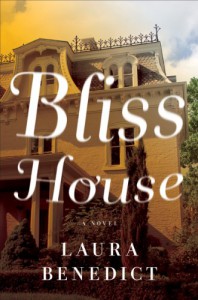Bliss House
 A key element to any successful haunted house story is an appropriate setting. The atmosphere surrounding the house is just as important as the mysterious happenings inside the house. In Bliss House, the setting does not fit the insidiousness of the house. For one, the story occurs during the summer months. Summer in Virginia is too bright, too hot, and too lush to appropriately convey mystery and gloom. Then there is the house itself. The rooms are bright and airy. The ceilings soar. For those rooms without windows, they are still open and big. They are less well-maintained, but a quick walk through the door leads one directly into the three-story open gallery. There is none of the dilapidation or closeness that typically identifies a doomed house. Between the blazing summer heat and humidity along with a recently renovated house, it is difficult to take Bliss House as a haunted house seriously.
A key element to any successful haunted house story is an appropriate setting. The atmosphere surrounding the house is just as important as the mysterious happenings inside the house. In Bliss House, the setting does not fit the insidiousness of the house. For one, the story occurs during the summer months. Summer in Virginia is too bright, too hot, and too lush to appropriately convey mystery and gloom. Then there is the house itself. The rooms are bright and airy. The ceilings soar. For those rooms without windows, they are still open and big. They are less well-maintained, but a quick walk through the door leads one directly into the three-story open gallery. There is none of the dilapidation or closeness that typically identifies a doomed house. Between the blazing summer heat and humidity along with a recently renovated house, it is difficult to take Bliss House as a haunted house seriously.Other issues with the story revolve around Rainey. As the main character suffering from guilt at the tragedy that left her a widow and her daughter forever scarred, readers should sympathize with her struggles to build a new life for herself and her daughter. Yet, readers will find it difficult to muster sympathy for her. Her story is tragic and pitiable; her reactions are not. She oscillates between smothering Ariel with attention and then virtually ignoring her. She is so afraid of her daughter’s feelings that she capitulates at the slightest hint of a battle and makes excuses for her behavior or absence. Yet, she feels no qualms about packing up and moving to Virginia without discussion. It is a contradictory attitude that diminishes one’s ability to sympathize with her. Ms. Benedict tries to overcome this deficiency by showing Rainey’s burgeoning awareness of her mishandling of the move and of Ariel. However, this occurs so late into the story that it becomes something of a moot point. In trying to develop a character still struggling with the psychological trauma associated with the death of her husband and with being the unwitting reason for the accident, Ms. Benedict creates a main character that is more pathetic than sympathetic. Rainey comes across as too annoying and self-centered to be wholly enjoyable.
Ariel also has her issues, but these are so much easier to stomach given her age and her part in the accident. One expects a teenager to be moody and difficult. Their emotions should fluctuate wildly and rapidly. When combined with the mental trauma of the accident and the psychological ramifications of her injuries, there is no surprise that she lashes out at her mother, blames her for everything wrong in her life, and uses that blame to get what she wants. Her attitude and actions not only meet a reader’s expectations, her unwitting manipulation of her mother fits well into the storyline.
The fundamental issue with Bliss House is that Ms. Benedict’s efforts to create a menacing atmosphere and a sympathetic main character ultimately fail. The writing is flat, and more importantly, the story progresses too quickly to establish the appropriate tone. In addition, there are no real answers about the house. Readers will still wonder how Bliss House became so ominous and if there are even more dark Bliss family secrets that made it that way. Instead, she solves the murder mystery, unveils a decades-old family secret, and resolves the issue of living in the house without touching anything else about it. In many ways, it is a disappointing ending because all of the key elements that should make Bliss House a fantastic story are there. Her execution of those elements and some of choices she makes regarding them prevent the story from being anything other than merely okay.


